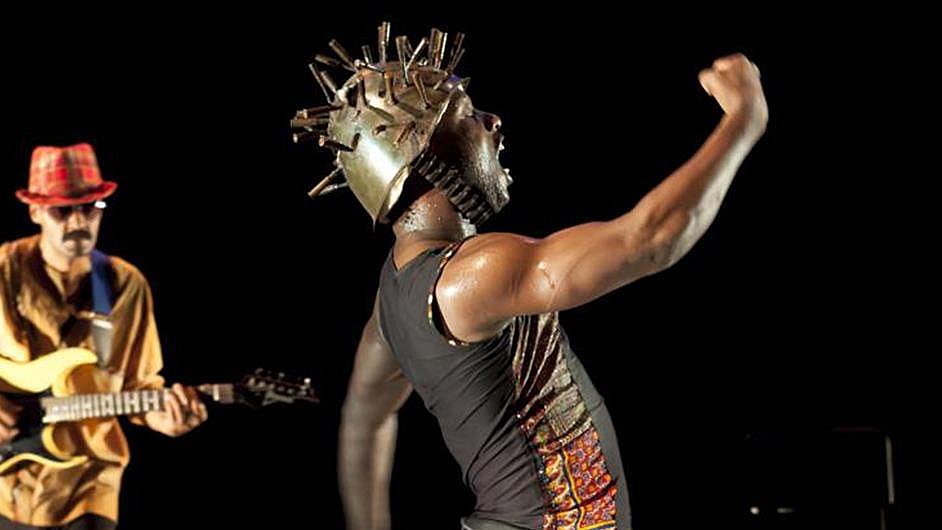
To spark discussion, the Walker invites local artists and critics to write overnight reviews of our performances. The ongoing Re:View series shares a diverse array of independent voices and opinions; it doesn’t reflect the views or opinions of the Walker or its curators. Today, dance artist Penelope Freeh shares her perspective on Saturday night’s performance of Time and Spaces: The Marrabenta Solos by Panaibra Gabriel Canda, the second evening of Tales of Home: Congo/Mozambique. Agree or disagree? Feel free to share your thoughts in comments!
There are stations onstage: a chair and amp on center, three microphones on stands in three corners and costume elements near the middle wing stage right. As the lights fade moments before the piece formally begins, a guitar player lays down near his equipment. Lights up and Panaibra Gabriel Canda, his back to us, speaks Portuguese into a mic, translations projected onto the scrim upstage.
Identity is outlined as a major theme here. With a clever trajectory of verbiage we become entangled in the macro/micro crisscrosses and crosses to bear of Canda’s personal history. He comes from a musician father and dressmaker mother from Mozambique, a country colonized by Portugal, turned communist, turned democratic. It is a confusing story that seems to have forced this contemporary dance and performance artist inward. Out pour guttural stutterings and a body wrestling with itself.
Intimate dances occur, accompanied by the virtuosic musicianship of Jorge Domingos. The two performers are always in counterpoint. Very little needs to be communicated between them in order to be completely on the same page. For a work with a subtitle that contains the word “Solos”, this reads very much as a duet.
Canda’s intelligent body holds many qualities and dynamic ranges. Initially making well-muscled arm gestures that repeat with accompanying text, he moves into more sinuous musings, traversing space. The geography is specific and seems to jump from the stage onto Canda’s very skin. I begin to perceive his body as a map, zones, multi-locations with various topographies. Stomping and gentle tapping accompany flinging arms and tight-fists. Grooves are interrupted and swell into eruption again and again, like water lapping.
A slow and deliberate crawl from upstage to down is my favorite moment, executed with profound coordination. We see the body lower then upright, and it is significant in its changing of planes. The bone and muscle dances begin under the low mic. We are reminded of what’s under the skin (that cannot be rubbed off, no matter how hard he tries). We are left with sweat and breath, a silent musician and a darkening space as we listen hard.
Get Walker Reader in your inbox. Sign up to receive first word about our original videos, commissioned essays, curatorial perspectives, and artist interviews.